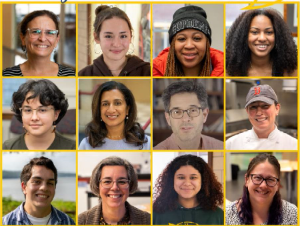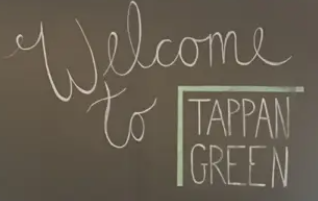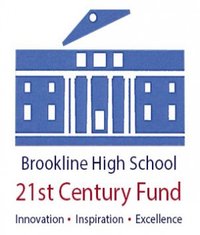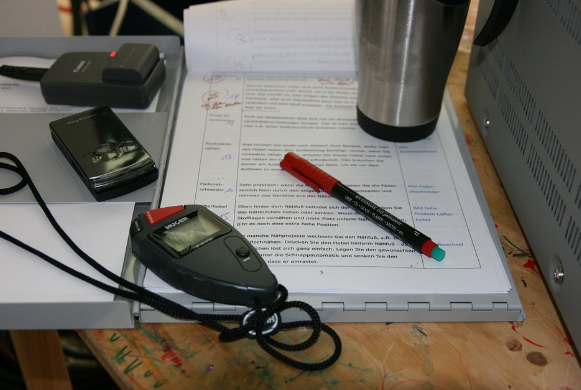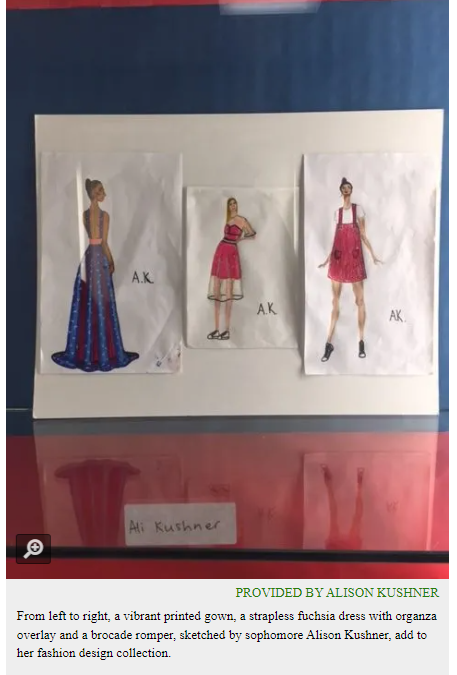How does a writing teacher return to the “beginner’s mind” of students, and how does doing so influence his teaching practice? Ben Berman shares how the frustrations he experienced and the lessons he learned when he tried to write a screenplay changed the way he approaches teaching writing to his high school students.
Despite the fact that I don’t own a TV, don’t subscribe to Netflix, haven’t been to a movie theater in years, and wouldn’t know a slug line if it slugged me in the face, I decided to add a screenplay unit to my creative writing class this year.
To prepare for this, I applied for a grant from the Brookline, Massachusetts High School’s BHS Innovation Fund to spend my summer working on my own original screenplay. Not only would this teach me a little something about the genre, I thought, but if I happened to pen a big hit I just might never have to cover lunch duty again.
As a poet, I had very little experience writing dialogue or plotting stories into three acts. But returning to beginner’s mind offered me many insights into the challenges that my students—who are often writing creatively for the first time—tend to face.
I have tried to describe, here, the messy evolution of my screenplay and how it’s changed my approach to teaching creative writing.
Writing the Screenplay
DRAFT 1: Transformations
My first idea involved a character that feels lost in the modern world until he starts helping out at a funeral home. I was particularly interested in dramatizing an inner transformation through motifs and spent a week meticulously plotting the story out and storyboarding some of the scenes.
But when I actually started to write the screenplay, I ran into the same problem that my students often face—my characters weren’t interested in doing what I wanted them to do. I’d planned their lives before I’d taken the time to get to know them, and I soon realized that I would need to start over with a new premise and new process.
DRAFT 2: Are We Here Yet?
A few days later, I ran into a former student who had recently graduated from college and was struggling to figure out whether to accept a job offer or spend the summer travelling abroad. She asked me for my advice. I asked her if she wanted to be the main character in my screenplay.
I started wondering what would happen if people didn’t actually have to make big life choices—what if my character could implant part of her soul into a pod and then send that pod abroad while she started her career? Would this solve my character’s problem, I wondered, or simply create new ones?
After working with this sci-fi premise for a little over a week and discussing it with everyone I knew, a screenwriter friend asked if I understood the whole budget aspect of films. What do you mean? I asked. If you set ten minutes of your film abroad, he told me, you add $100,000 to your budget.
And I realized that I was still writing with the freedom of a poet, rather than attending to the realities of this new genre.
DRAFT 3: The Fad of the Land
The next day, I was at the farmer’s market with my daughters when I saw a sign for Paleo Cookies. Paleo cookies? I thought. What Paleolithic ancestor ate vegan chocolate chip cookies sweetened with agave nectar?
I decided to start over entirely and write a comedy about two rival groups—the Paleos and the Kaleos—at a farmer’s market.
I knew right away that this was a dumb idea—that I was writing a skit and not a feature-length film—but sometimes pursuing dumb ideas is an essential part of the creative process. It pressures us into a minor existential crisis, forces us to step back and reconsider our connection to our work.
And as I was thinking about why people would want to return to the traditional diets of our ancestors, I started contemplating my own relationship to the modern world, how the experiences that have felt most transformative to me—serving as a Peace Corps Volunteer and becoming a father—both involved a return to simpler ways of living.
DRAFT 4: Vicarious 1
All of a sudden, I started to see some connections and patterns in my drafts and realized that what I really wanted to explore was this: In what ways do the modern technological advances in this world help us feel more fulfilled? In what ways do they only exacerbate our loneliness?
I decided, then, to return to my previous sci-fi premise. My next draft was called Vicarious and was about a woman trying to save her family’s pod service company from being sold to a hedonistic rival group.
This draft seemed to be going quite swimmingly—I felt deeply connected to the existential anxiety of my characters and had written half the screenplay when I realized that while I’d surrounded my protagonist with all sorts of interesting, quirky and troubled characters, she was primarily a witness to the world around her—no struggles, desires or conflicts—and therefore no potential for an interesting arc.
I was disappointed that I was going to have to start over again—but I knew, too, that a heightened awareness of problems in a creative work is always a healthy sign.
DRAFT 5: Vicarious 2
So after three weeks of getting to know my main character, I decided to get rid of her. I kept the sci-fi premise but chose one of my minor characters to be my new protagonist—someone who uses her pod (now called Vikes) to avoid and escape—and someone with the desire to change, as well. Finally, I had both a plot and main character with potential, and the first twenty pages of the screenplay flew out of me in less than a week.
The only problem, now, was that summer was over.
Some Takeaways
I went into this project thinking that it would teach me the craft behind screenwriting. And in many ways it did. But the real question that emerged for me was this: How do we help students embrace the incredibly messy process of creative work?
You Say Revise, I Say Revive
It took me five different story treatments and well over 200 pages of writing to net the first act of a screenplay. Yet each attempt was a better failure than the previous one. And that’s not just because I’m a really bad screenwriter—every poem I’ve ever published has a hundred pages of failed drafts behind it.
And yet something that felt like such a natural part of the process to me—starting over—was something that my students always seemed to resist.
One strategy that I tried out this year was having my students write vision statements (sometimes called What-the-Hell-Am-I-Doing Statements) after they completed their first drafts.
One student, for example, had written a ten-page screenplay about the fallout between three friends after two of them begin dating. In her first draft, she followed the arc of the character that became the third wheel. But in her vision statement, her story was exploring what it means to follow your heart even if it hurts someone else.
When we sat down to conference and recognized this disconnect, it was like a split-screen scene out of Annie Hall.
Now you just have to switch main characters and rewrite the story, I said.
Now I have to switch main characters and rewrite the story??!! she said.
Once she accepted this, she produced a much more realized draft. And I realized how important it is to build enough time into my units for deep revisions, to teach students the difference between finding material and shaping material, and to convince them that starting over is not a step backward but a step forward in a better direction.
Breaking Those Seas Frozen Inside Our Soul
But if I was going to ask my students to commit to deep revisions, I needed to help them think of their work, as Frost wrote, as (a screen)play for mortal stakes.
Another student, for example, turned in a first draft that was fifteen pages long and followed eleven different characters. When we sat down to conference, I suggested that she, umm, perhaps, choose one or two characters to focus on.
I can’t, she said.
Why not? I asked.
I can’t decide which one, she said.
And then suddenly she was on the verge of tears, talking about the college process and having to decide between theater and field hockey, and these two very different boys that she kinda liked, and how she never really knows what to do, and how her plot (or total lack thereof) was just one more example of her inability to ever make a decision about anything.
After depleting our class’ PTO-sponsored box of tissues, we stepped back and realized that maybe what she really needed to do was transfer her own personal struggles onto her characters and let them deal.
She wrote twenty brilliant new pages over the weekend, following the story of a young actor struggling to decide whether to accept a role in a movie in which he’d have to appear nude.
When we first sat down to conference, I had thought she needed help understanding the art of rising action; it turned out that she just needed to find a theme that she cared deeply about.
Putting My Grades Where My Mouth Is
If I wanted my students to embrace the messiness of the creative process, I needed to shift how I was grading them and put much more weight on process, learning, and habits of mind.
I had one student, for example, who decided to adapt his favorite sci-fi book into a screenplay. His final product was pretty good, but it wasn’t until I read his reflection—where he documented the struggles of his process—that I was truly able to see just how much he had learned. Here is a paragraph from his reflection:
I began with the main events that I knew I wanted to transfer from the book to my screenplay, and wrote them down on a timeline. I then got more and more specific, choosing what events I wanted to translate, and ordering them in a way that both made sense and followed the three-act structure that movies so often do (in a book, for example, climaxes are not built up to as dramatically as in a movie). This turned out to spawn a sort of liar’s paradox, because whether a specific event could be included often depended on if there was a place for it, but where an event was to go often depended on whether another event could be included. In addition, the interwoven subplots and their subtle interactions with the main plot made the process somewhat like that of putting together a jigsaw puzzle made of shape-shifting pieces.
In creative projects, our learning is often inversely related to our success. My best students weren’t necessarily the ones who were producing the most polished pieces—they were the ones coming away from their experiences with the most nuanced understanding of the challenges they had faced.
Conclusion
Slogging through my own screenplay made me realize that while I was offering students many opportunities to be creative, I wasn’t really teaching them how to be creative. I was showing them what good writing (the noun) looked like, but I wasn’t teaching them what good writing (the verb) looked like.
Even in my creative writing classes, I tended to offer students neat packages of learning with a focus on product over process: here is some content, here are some skills, here is an assignment that will measure your learning.
But the creative process looks more like this: here is a setback, here is a minor epiphany in middle of the night, here is where you need to start over.
Just the other day, I received the following email from one of my students on the verge of completing her first draft of a twenty-page screenplay.
I just woke up in the middle of the night (it’s 3:25 am) and realized I’m not really passionate about my story. I think it strayed way too far from what I originally wanted to accomplish because looking back that goal was a little too big and overwhelming. So now it’s turned into something completely different that I barely have any personal connection to. So I’m kind of freaking out here. I want to rewrite it but I’m worried it’s too late. What should I do? Ahhhh!!!
And as messed up as this sounds, I almost cried tears of joy.
Teaching craft is essential. But if I want my students to think of writing as a lifelong apprenticeship, what I really need is to teach them to embrace the spirit of what Beckett meant when he said, Ever tried. Ever failed. No matter. Try again. Fail again. Fail better.
Ben Berman began his teaching career as a Peace Corps Volunteer in Zimbabwe. He then spent eight years teaching in the Boston schools and has spent the past eight years at Brookline High School in Massachusetts, where he teaches creative writing and helps run the Capstone program. His first book, Strange Borderlands, (Able Muse Press, 2013) won the Peace Corps Award for Best Book of Poetry, was a finalist for the Massachusetts Book Awards, and received a starred review from Publishers Weekly. His new collection, Figuring in the Figure, is recently out from Able Muse Press. Berman is the poetry editor at Solstice Literary Magazine and lives in the Boston area with his wife and daughters.





